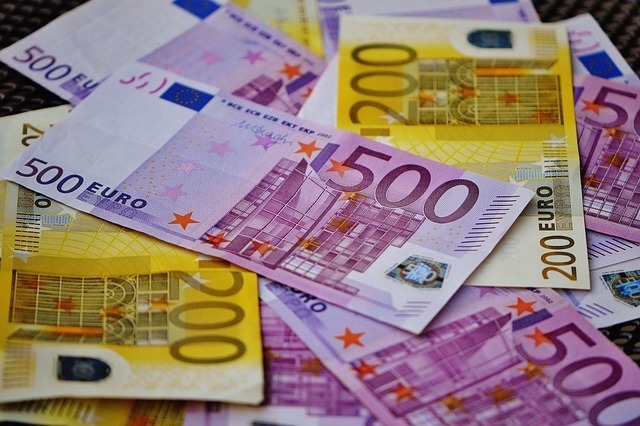In this article, we have covered the highlights of global market news about the USD/CAD, EUR/USD, GBP/USD and NZD/USD.
USD/CAD Price Analysis: Bulls around 1.3765 resistance inside the weekly triangle
While it registers modest gains around 1.3735 throughout early Monday AM in Europe, USD/CAD recovers the early Asian session losses. In doing so, the Loonie duo defends the recovery movements from the previous day within a symmetrical triangle that has been in place for a week.
Nevertheless, the inability to break the 1.3685 support confluence encompassing the 100-bar Simple Moving Average (SMA) and bottom line of the indicated triangle may contribute to the quote’s recent comeback.
The stable RSI (14) and absence of negative MACD indications support the recovery advances.
The Loonie pair is thus prepared to test the 1.3750 50-SMA resistance level. However, the essential line to monitor after that is the top line of the mentioned triangle, which is close to 1.3765.
The monthly high of 1.3861 may serve as a stopgap if the quotation holds steady above 1.3765 before driving the USD/CAD price up towards the previous annual high of 1.3977 and then towards the 1.4000 psychological magnets.
To persuade USD/CAD bears, however, a clear breach of the 1.3685 support confluence is required.
Yet, several supports at 1.3650, visible in late February and early March, may put the Loonie pair sellers to the test before giving them the upper hand.
EUR/USD Price Analysis: Bullish RSI Points to 1.0700
During the previous trading day, EUR/USD broke beyond the 21-Daily Moving Average (DMA), and the positive momentum continued into the new week. A weaker US Dollar, driven by declining US Treasury bond yields, helped the pair.

The global rates, particularly the US Treasury yields, are consistently hammered by financial instability. On the other hand, international central banks’ daily reintroduction of the swap line would allay liquidity worries, putting downward pressure on the safe-haven US Dollar. The positive bias for the EUR/USD pair is thus expected to hold.
The triple point, which consists of the often challenged resistance at 1.0750 and a descending trend line drawn from the high reached in February at 1.1022 and anchored by the 50-Daily Moving Average, is where the short-term support is observed (DMA). If that level is broken, the EUR/USD will probably go towards February’s high at the crucial psychological threshold of 1.1000.
The 21-DMA, slightly above the day’s closing point at the level of 1.0600, will probably continue to act as a protective stop for any further downward movement. The multi-month low at 1.0520 will be the final point of support.
The Relative Strength Index (RSI) indicates a higher high, indicating more upside potential.
GBP/USD struggles to reclaim 1.2200 as investors get concerned over Fed-BoE policies.
In the early European session, GBP/USD is making some serious efforts to retake the round-level resistance of 1.2200. The major fluctuate within a small 1.2168–1.2203 range. Investors are waiting for the Federal Reserve (Fed) and the Bank of England (BoE) to declare their interest rate decisions, which will be made on Wednesday and Thursday, respectively. The Cable is failing to produce definitive action and is exhibiting a muted performance.
The S&P 500’s future is pretty volatile. The 500-US stock basket has given up all of its early Asian gains. Market players are not encouraged by UBS’s attempt to save Credit Suisse. According to BBC News, Credit Suisse shareholders were denied the opportunity to vote on the transaction. They would instead get one share of UBS for every 22.48 shares they already own, valuing the bank at $3.15 billion (£2.6 billion). To restore customer trust, several central banks have stepped forward to provide liquidity support to rescue the second-largest Swiss bank.
Demand for US government bonds has been influenced by the news of liquidity assistance to revitalize the 164-year-old bank. The yield on the 10-year US Treasury has increased over 3.42% as increased liquidity flushes may rekindle inflationary pressures.
NZD/USD Price Analysis: Reaches 200-EMA at 0.6250; buyers remain optimistic
NZD/USD records its first daily loss in three days as bears tinker around the 0.6250 mark ahead of Monday’s European session. The Kiwi pair then reverses from a sloping resistance line from late February and declines toward the 200-bar Exponential Moving Average (EMA).

Even if the NZD/USD bulls face resistance from a one-month ascending trend line at 0.6285, the pair’s persistent trading above the important EMA and the positive MACD signals maintain optimism among purchasers.
Nevertheless, in addition to the 200-EMA level around 0.6240 and a one-week-old upward-sloping support line near 0.6175 at the latest, the NZD/USD pair’s short-term downside is also constrained.
The possibility of a decline towards the monthly low of 0.6085 cannot be ruled out if the Kiwi pair falls below 0.6175.
On the other hand, for the quotation to move toward the highs established in early February around 0.6390, a clear upward breach of the indicated resistance line, at the latest near 0.6285, would need confirmation from the 0.6300 round figure.
A run-up towards the Year-To-Date (YTD) high of over 0.6540 can occur afterwards.
In conclusion, despite the most recent failure to break over the short-term resistance line, NZD/USD is still on the bull’s radar.
Please click here for the Forex News Updates from 17 March, 2023.


